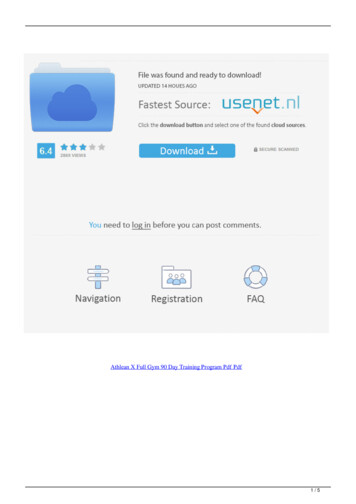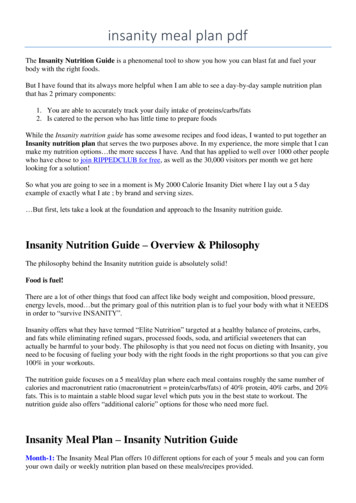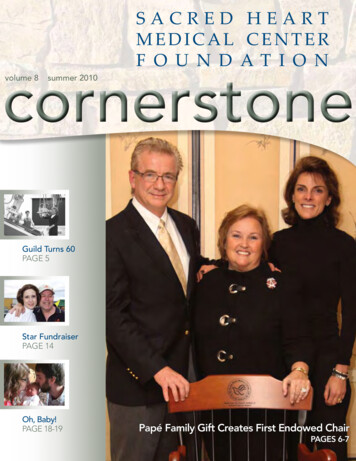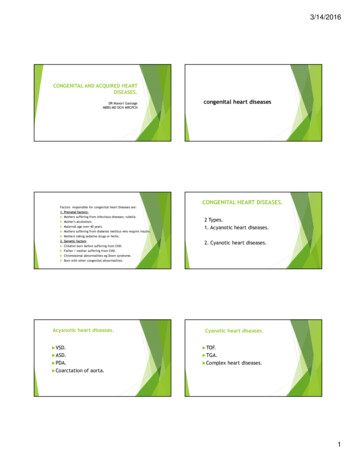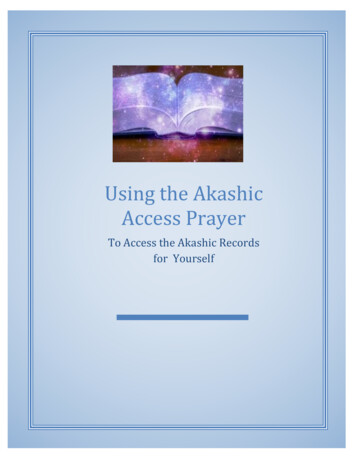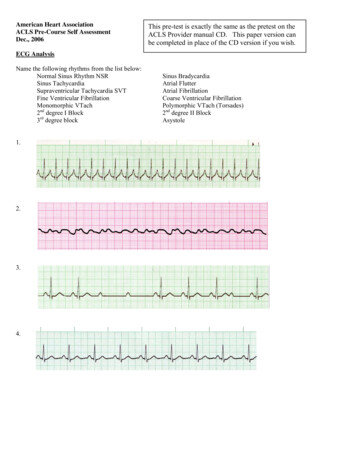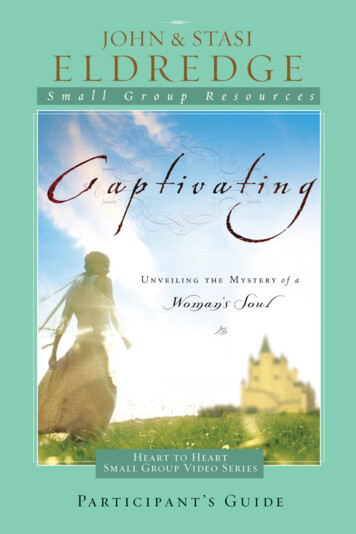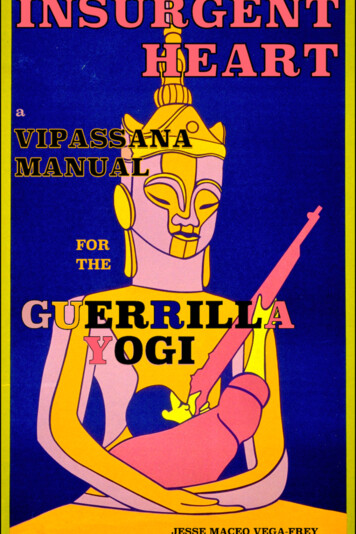
Transcription
INSURGENTHEARTAVipassana Manualfor theGuerrilla YogiJESSE MACEO VEGA-FREY
This work is licensed under the Creative Commons Attribution 4.0International License.To view a copy of this license, visit http://creativecommons.org/licenses/by/4.0/or send a letter to Creative Commons, PO Box 1866, Mountain View,CA 94042, USA.You are free to:Share — copy and redistribute the material in any medium or formatAdapt — remix, transform, and build upon the materialfor any purpose, even commercially.Under the following terms:Attribution — You must give appropriate credit, provide a link to thelicense, and indicate if changes were made. You may do so in any reasonable manner, but not in any way that suggests the licensor endorses you oryour use.No additional restrictions — You may not apply legal terms ortechnological measures that legally restrict others from doing anything thelicense permits.*OSPAAAL poster art by Rafael Zarza / Image courtesy LincolnCushing / Docs PopuliDo Less For Peace. 2020. (&
NAMO TASSA BHAGAVATO ARAHATOSAMMĀ SAMBUDDHASSAHomage to the blessed one, the worthy one, the fullyself-awakened one*For my parentswho taught me how to love —and how to fight.
CONTENTSForeward8Preface13Introduction221. Sabotage: Dāna - Silā 472. Indigenous Knowledge: Bhavana743. Contact: Aim - Attack / Harass944. Mobility: Bases - Fluidity / Agility 1185. Distrust : Suspicion - Investigation 1406. Medicine: Mettā - The Divine Abodes7. Retreat: Encirclement - Escape1611868. Diversion: Distraction - Misdirection2079. Strike: Stillness - Cessation 22910. The Guerrilla Unit: Camrades - Community25211. Independence: Autonomy - Self-Retreat 2766
Insurgent Heart12. The Revolutionary Spirit: Discipline - Determination - Faith29713. Intelligence: Reporting - Education - International Support31914. Protracted War: Land Reform - Crisis - Buildinga Regular Army340Epilogue: Mindfulness - A Balm or Bomb for Babylon 372Acknowledgements7395
FOREWARDON A COLD MORNING in early March of 1970,just as the crocuses were starting to come up, I found myselfdumping two molotov cocktails into a dumpster outside mycollege—praying that this was the place they would do theleast harm. Within a few hours, I packed my bags and droppedout of school.It was my freshman year and a time of great angst and protest—at my school and across the country. During the fall andwinter I had been working with a group of other students at anearby day-care center and a soup kitchen run by the BlackPanthers. Most of these friends were African American and hadbeen involved in a long frustrating process of petitioning theschool administration for basic academic and social accommodation and were being stonewalled. That spring, tensionsacross campus were peaking and emotions were quickly escalating.Late one night—suddenly and with little explanation—some of us were brought together and put to work makingmolotov cocktails. Quite a dramatic turn of events! Studentswere planning to occupy one of the dorms on campus the nextmorning and these weapons were to play some unclear part.My friends were justifiably fed up with the administration andfelt the need to increase pressure in order for their requests tobe taken seriously. They were asking for so little and I wasfurious about how irresponsibly the administration was acting.I shared the sense of urgency for the need for action. But at the8
Insurgent Heartsame time, as I was walking toward the dorm with the molotovcocktails in the pockets of my coat, I knew deeply in my bonesthat I did not want to hurt anyone.It was still early as I walked across campus. I rememberthe smell of the gasoline, the weight of the bottles in my coatpockets, and the weight on my heart. I cared so much aboutthe cause we were fighting for and felt terrified and ashamedat the thought of betraying my friends at a crucial time—especially as a white person. But I could not ignore the explosion of epiphany that had detonated in my heart. I did notwant to harm. Mine was a path of peace. I knew it.There were very few people around at that hour but, bychance, I bumped into my ecology professor—someone whohad made a profound impression on my life already. He was acommitted Quaker and always seemed to exude a deep senseof reassurance and peace. The previous day he was so upsetwith the administration and overwhelmed by the turmoil thathe left school and put a sign on his door: “Spending the day inthe woods. Back tomorrow.”When I saw him, I realized he was just coming back towork after taking that time to immerse himself in the forest.He had returned to resume his work, palpably reconnected tohis inner compass. I started crying. He told me, “You need tofind out who you want to be this lifetime to work your wholelife to bring about positive change 100 years from now.” Ithanked him and took a sharp right to put those bottles in thetrash.I wanted the harm to stop. But I didn’t want to createharm in the process. When we deeply care about and connectwith the pain and suffering in this world, we want to do what9
Forewardwe can to bring relief to and end that suffering. But how do wefight pain without creating more of it? How do we deeply careand commit to end suffering through a path of peace? Myprofessor's infusion of clarity helped me get immediatelyclearer in myself about my own motivation. It also led me to amore dedicated search to find my own lifetime path.In 1975 I did my first two-week vipassana retreat andfound the way of life I had been searching for. In 1984 I cameto study under the guidance of Sayadaw U Pandita of Burma.He was a warrior in the most profound sense. Sayadaw helpedme understand that this path of peace is not a rejection of warbut of bringing the war under the firm authority of morality,kindness, and clarity.The Buddha used a lot of war imagery to teach us howto find peace. These metaphors are essential but they alsorequire some spiritual translation to be used effectively. Thecontemporary mindfulness movement usually tries hard todismiss or sugar-coat the war aspect of the Buddha’s teachingto make it easier to swallow. The movement has done well totry to heal the predominant patriarchal culture that has beenso intensely macho: the toxic unhealthy masculine dominatingthe toxic dominated unhealthy feminine – both of which operate insidiously within and without us all. Indeed, most of usneed to learn how to cultivate a relationship of kindness withthings as they are. Our hearts and our world need so muchhealing. But we also need incisive and discerning clarity—which does not come from love alone. The great Indian saintSri Nisargadatta Maharaj said, “Believe me, there cannot betoo much destruction” and we need to take that to heart as wealso try to build a loving, wholesome world. Complete libera10
Insurgent Hearttion necessitates a journey of learning to access a healthymasculine and feminine energy by facing their toxic sides.In Insurgent Heart, Jesse does not shy away from facingthe Buddha’s war imagery. He not only faces it, he stares itdown, and translates it with the deepest kindness and wisdom.He shows us how to find peace through understanding the waythe Buddha taught to win the war. Jesse explains how to usethese modern astute guerrilla war tactics as helpful tools tofight the most Noble war: liberation from greed, hatred, anddelusion.Jesse clarifies the path to liberation in our times. Hehelps us understand how to cultivate and harness healthymasculine energy as well as healthy feminine energy. Jesseinstructs how to resolve this kind of paradox: how to cultivateboth the soft, gentle, and kind with the firm, courageous, andstrong. This is no small matter! How to balance heroic energywith gentleness becomes a spontaneous and auspicious way oflife—and is the path to peace of the guerrilla yogi.When you read this book, you will receive a delightfuland practical abundance of deep liberation teachings, passeddown to me from Sayadaw U Pandita: the Buddha’s instructionon how to liberate yourself. All that we need to know. You willalso learn how successful guerrilla warfare tactics can help ourpractice so we can apply that inwardly in order to truly winthis war. Awesome!!!!It is very hard to make this a way of life, to be in it forthe long haul. To resolve paradox-to be connected but freewithin the vastness of the joy and sorrow in this world requiresa nearly impossible commitment. But all noble work feels11
Forewardimpossible, requires tremendous courage, and is the mostworthy of our effort.Jesse is a keen, quiet disciple of the Buddha. I have along-standing respect for his meditation practice. He is intensely dedicated to uprooting greed hatred and delusion withinhimself and all beings. I appreciate that he has traveled wideand deep in outer and inner liberation circles and that he takesthe time to reconnect with his Dhamma roots in Burma nearlyevery year. He sits at least one month-long retreat each year,and longer whenever he can. Jesse strives toward this freedomwith as much dedication and care as I have seen.I encourage you to read this book to the end. His understanding of how to teach. impeccable.Michele McDonaldMay 1, 202012
PREFACEAS A KID, my parents brought me to a lot of demonstrations:housing rights protests, anti-war protests, union rallies, picketlines, strikes, boycotts, ballot initiative demonstrations, and thelike. My children’s books were steeped in critiques of capitalism, racism, and sexism and celebrated cultural and politicalheroes and heroines from around the world. Even my nurseryschool organized us on a peace march. Plenty of nights duringmy childhood were spent at meetings where I was lucky ifthere were any playmates my age. My parents were part of alarger community of friends who grew up together in politicalorganizing and community building. Joy and struggle werewoven into our lives at every turn. My mother helped buildcommunity very literally — as a nurse midwife dedicated topublic health and access to affordable care for women, poor,migrant, and other disadvantaged people. My father, a community organizer, helped build neighborhood strength in ourcommunity through the creation of affordable housing, festivals and block-parties, after-school programming, and grassroots economic initiatives.The art in our home was as much about politics as itwas about beauty. The music that played throughout the housecelebrated life and struggle. Our practice of family was intended to align our actions with our beliefs about our world, ourcommunity, and our relationships. Solidarity, really, was ourreligion.13
PrefaceAnd it was not always harmonious. There were frequently ways in which the approaches of my father and mymother conjured an impressive dissonance. Aligned with theirtraditional gender norms, my father was often more dedicatedto principle and my mother more to spirit. In our householdthe struggle for supremacy (or search for balance) betweentruth and beauty, honesty and compassion, reason and care,righteousness and love, rigidity and permissiveness was aneveryday affair.While the dynamic tension played out between myparents, and between us all, the internal dimensions for mewere no less significant. We honored leftist revolutionaryleaders of history and yet readily admitted the many flaws oftheir personalities and the programs they put in place. Theways in which so many of our movements for freedom hadmanaged to replicate systems of oppression in their efforts forliberation instilled a conundrum in my own mind, muddied myown vision for the world and for my role in it in ways thatpersist today.What always seemed clear was that social change takesforce. But force almost always seemed to mean violence. Therewere leaders I learned about — like Harriet Tubman, MahatmaGandhi, Martin Luther King Jr, and Nelson Mandela — whosepower seemed to emanate from a kind of inspiration thatdidn’t require violence and which would have actually beendiminished by it. But they seemed much more rare than thosewho were able to galvanize the frustration of the masses anduse that energy to violently topple oppressive regimes. Learning eventually that Tubman did carry a weapon, that Mandelahad roots in more violent campaigns, and being challenged14
Insurgent Heartwith the truth of Malcom X and the honesty of his anger complicated my understanding even further.It was not until I encountered my own training in vipassanā meditation and the Buddha’s teachings that I found ascale at which the impulse toward freedom and the mechanicsof violence were clearly at odds; where love and interest werethe only tools of revolutionary change that actually worked.Liberation in the Buddhist sense also takes tremendous effortand I eventually was able to witness the very subtle differencesbetween effort motivated by craving or aversion and effortmade by care or interest — full-of or free-from expectation.From those subtle differences larger impacts became evidentand the process between volition and action and action andimpact — something we would call kamma (karma) — becamemore and more clear.This sensitivity is not always how my tradition has beentaught. Much of the training in Theravada Buddhist systemsover the centuries has encouraged a much more combativeapproach to meditation: a patriarchal mode that emphasizesextreme effort and forcefulness of mind, of penetration of theobject of awareness, of relentless determination and unwavering diligence. In our cannon, the metaphor of war betweenhealthy and destructive forces of mind is elaborated upon ingreat detail. Lovingkindness, patience, relaxation, and resthave been treated as less important, implicitly or explicitly,and so the flavor of the teachings have been molded in a veryparticular form that one could easily interpret as out ofbalance.My own teacher, Michele McDonald, studied and practiced for many years under one of the most rigorous Burmese15
Prefacemonastic teachers of our era, Sayadaw U Pandita. Amazinglyshe was able to learn for herself how to balance his militantapproach with her intuitive knowledge of her own needsregarding the force and pace of change. Like any great female“first” in a patriarchal institution or culture she had to proveher capacity to operate on those terms while secretly buildingan approach that kept her in balance. Perhaps her greateststrength was in not rejecting the training of her overbearingguide but instead to see its benefits and put it into healthierrelationship with the other side of her spiritual practice thatrequired a deeper commitment to compassion, patience, joy,and the nourishment of forgiveness.From the beginning of my own meditation practice (andcertainly earlier than that) I had internalized the idea that thiswarrior archetype was the embodiment of the most importantprinciples of spiritual and social pursuit. Over and over again,through convulsions of force and failure, I found that approachlimited and undermining. But when I abandoned the warriorspirit altogether I found my practice vapid, rudderless, andambling. The path to freedom requires a broad range of capacities of heart and while combat is not the only — or even mostimportant — metaphor for our practice, it is a valid one andone that we must find a way to come to terms with. While notrejected, it must still be balanced and sometimes we struggleto find meaningful archetypal models for what that dialecticalembodiment might look like.I have been unbelievably blessed by the integration anddigestion of these polarities already done by my parents andmy teacher before me. And yet I know I must embody thetension myself and let it work on me as I walk through this life.16
Insurgent HeartAll of us must do the work on our own, must find our footingon the spectrum of effort and effortlessness and of love andwisdom and be open to the surprising ways we may find they— and all other spiritual matrices — interact. I have completeand utter confidence in the approach my teacher has taughtme and trained me in: one that allows for a wide flexibility ofapproach held firmly within the rigor of the overarching strategy of our tradition.When my father died, I inherited what I could manageof his vinyl records and his revolutionary literature. I wasinitially drawn toward the works of Karl Marx in my thirst tomore clearly understand the nuances of his analysis of thecurrent socio-economic system and the possibilities of another.For some years I kept my distance from the handful of booksthat laid out explicit theories of revolutionary war as the moralchasm in relationship to violence caused uncomfortabletremors to burden my heart.When I finally began to read the military works of CheGuevara, Mao Zedong, Ho Chi Minh, T.E. Lawrence, unnamedIrish Republican Army tacticians, Kwame Nkrumah, Lenin andnumerous others that related to the strategies of guerrillawarfare, I came to see that in martial terms they shared anuncanny resonance with the mode of meditation practice that Ihad learned and adopted from my meditation teacher: Move inwhen you feel strong but move away when you are beyond thelimits of engaging fruitfully, recognizing that this flexibilitybuilds strength over the long-term. From there I could sense akind of overtone resonance with the approach explored by myparents’ relationship to change. These layered harmonicsprovided me an unexpected mechanism by which a metaphor17
Prefaceof military strategy could guide me toward the resolution ofmy tension with the traditional interpretation of the Buddha’sapproach to meditation, which differed in important ways fromthe practical methods that I had come to find so much faith in.In this process I came to understand mine as the method of aguerrilla yogi and over time have felt compelled to expand itinto a framework that can be shared.Though these war themes are offered as metaphor it isimportant to acknowledge that the guerrilla leaders who arequoted throughout this book are not speaking metaphorically:they are talking about killing people. In their real life missionsmany of them perpetrated unspeakable harm in their efforts toliberate their people. Anyone sensitive to the insanity of theCultural Revolution might well be triggered by the quotationsfrom Mao Zedong. For people pained by exile or whose property was expropriated by the Cuban Revolution, Che’s words mayvery well spark a negative reaction. For anyone attuned to therole of people like “Lawrence of Arabia” played in promotingan orientalist view of the middle east, his words may grindtoxically in your heart. As the quotations are almost all relatedto military strategy it is probably unsurprising there are veryfew female voices quoted here — but that will itself likely betroubling for many readers. Elevating these voices, almostentirely male, knowing what we know about the outcomes ofsome of their actions, is a delicate and complicated endeavor.To make it more complicated, while most of the examples used in this book are representatives from left-leaningmovements, which may sometimes be more sympathetic tomany Western Buddhists, we are living in a time where manyreactionary and right-wing fascist elements are using the18
Insurgent Heartstrategies of guerrilla warfare to impose immoral and inhumanconditions on society. Neo-nazi movements in the UnitedStates and Islamic fundamentalists like Al Qaeda and ISIS arestudying and learning these same tactics to overcome far morepowerful state enemies and are wreaking havoc around theworld.Finally, we are living in a time of the rise of right-wingBuddhist nationalism around the globe. We read every dayabout monks in Burma and Sri Lanka threatening and encouraging violence against minority groups — particularly Muslims— that are perceived as cultural threats. The understandabledissonance many people feel between the teachings of theBuddha and these expressions of violence can feel irreconcilable.We live in a social era that assumes and reinforces anunbridgeable polarity between Thich Nhat Hanh and Ho ChiMinh, between the Dalai Lama and Mao Zedong, betweenMartin Luther King Jr. and Malcom X, between Jesus and theMaccabees. But if we listen to our hearts honestly we will hearvoices from across this spectrum and we must wonder if thereis there a conversation to be had between these “opposites.” Ibelieve that these contrasting positions represent powerfuldimensions of spiritual and material paradox that should beengaged with and digested. It is spiritual and philosophicalwork that all who care about the world and care about themselves are called to wrestle with.We want peace and we are at war. This is true in ourlives and in society. In our spiritual and social justice practicesthere is always going to be the powerful tendency for us toavoid paradox, to choose one side and reject the other. Rather19
Prefacethan simply succumb to this conditioning, we have anotheroption: to wrestle with the dilemmas of the path to peace thatwe have inherited and use that process as a one of growth andunderstanding. Through this process we may come to appreciate that the Buddha’s middle path is not merely the refutationof extremes but the resolution of paradox.We are not beyond violence and will not get there byignoring its potency in our hearts. We are compelled in oursociety to glorify our saints and cast out our demons. But theremust be a possibility for a more mature reflection on motivation and action, on inspiration and corruption — one thatallows for transgression and transformation and finds thespiritual and social value of that. After all, we cannot deny theresonance between the basic impulse and action that many ofthese revolutionaries have been motivated and ourselves —aggrieved by the suffering in the world and inspired to changeit and find a way out,It is not the rebels that create the problems of the world,but the problems of the world that create the rebels. Ricardo Flores Margón1In Margón's quotation, the word “yogis” could easilyreplace “rebels” and sound as if it came directly out of our owntradition. The guerrilla method of vipassanā is where theMiddle Path meets the Shining Path, where Thich Nhat Hanhmeets Ho Chi Minh, where the Dalai Lama meets Mao Zedong.Just as the Buddha insisted on non-violence but found value inthe war metaphor, I believe we can, to some degree, separatethe inspiration and tactics of these revolutionary fighters from20
Insurgent Heartthe harm done by their actions in the world and watch theconversation they have. Without the metaphor most of us loseimportant possibilities for imagining the path to liberation forourselves. This is the function of story, of metaphor, of archetype — and it is this level at which I seek to engage.I am increasingly careful about claiming anything aboutthe perfect scalability of the spiritual and political paths ofhumanity. I have never been convinced that social change isprimarily a spiritual project2. Like the relationship betweenquantum mechanics and Newtonian physics, I sense that theyare in vital conversation with one another but that there areplaces where the laws at play are quite different. Either way, Iam always keen to look more closely to try and understand theplaces where these paths resonate and where they don’t. Bothhave fundamentally important things to teach us about thenature of individual and collective change and we shouldalways be open to possibilities beyond our imagining.Jesse Maceo Vega-FreyAugust 3, 201921
INTRODUCTION VIPASSANĀ:Come for the Peace, Stay for the WarGreater in battle than the man who would conquer a thousand-thousand men, is he who would conquer just one — himself. Buddha, Dhammapada1AT THEIR DEEPEST LEVEL,everything we cansee, hear, smell, taste, touch, or cognize — all “conditionedphenomena” — are impermanent, undependable, insubstantial.From a tree to a mountain to a sound or a thought, anythingthat arose because of a coming together of conditions willchange and pass away as those conditions change. This includes every aspect of what we think of as our “self.”The instability and undependability of reality creates thefoundation of the totality of our suffering as living beings:regardless of our effort to control experience we are separatedfrom the pleasant, joined with the unpleasant, and cannotalways get what we want. Responsibility for what befalls uscan be pinned on any number of agents in our lives or inhistory or society. But well beyond this is the fact of the inher22
Insurgent Heartent nature of the undependability of all phenomena. We struggle against the instability of life by grasping at pleasure, recoiling from pain, and numbing ourselves to the hardship throughfantasy and delusion. The mind asserts itself against the wind:It is a portion of our beauty but the totality of our grief. Themore we grasp, reject, or ignore the more the forces of greed,hatred, and ignorance are engrained in our hearts: as a learnedprotection from the undependable nature of reality. Over time,these patterns become a problem themselves as they entwineand operate in the most pronounced and subtle levels of ourexistence, forming the structure of most of what we considerour self.The Buddha taught what has come to be known assatipaṭṭhāna vipassanā practice as a way to cultivate the mind’sability to uproot these mental defilements through observation.He understood that greed, hatred, and ignorance arise simplybecause the mind is not trained to see the nature of reality as ittruly is. Experience is moving so fast it is very hard to observeclearly. Sounds, smells, tastes, sights, physical sensations, andmental activity are all streaming by at incredible speeds andgive us the impression of solidity, and of a coherent self at thecenter of experience.The basic method of vipassanā practice generally beginswith the attempt to bring the attention to one primary objectof experience, the breath for example, and develop concentration and mindfulness of the object. It is a very particular andrare kind of attention that is necessary to achieve vipassanāinsight: a delicate but forceful balance of concentration that ispowerful but nimble enough to move with the changing objectand mindfulness that is genuinely interested and not manipu23
Introductionlative, supported by courageous energy, calm, equanimity,love, patience, urgency, to name only a few. The Buddhaidentified four fields of experience in which we can applymindfulness to achieve insight: body (and the physically-basedsense experiences of seeing, hearing, smelling, and tasting),feeling tone, mind states, and the causal relationships betweenphenomena: basically all and any conceivable human experience. Most Buddhist meditation traditions emphasize a particular object over another or particular aspects of concentrationover another. Whatever method we use the mechanics ofliberation are essentially the same. Transformative insight canhappen in relationship to any object. While we may train withone, like the breath, ultimately we develop the capacity to bein profound investigation with any object that arises in ourfield of awareness.Thus trained, the mind begins to see phenomena assimply a chain of causal or conditioning experience, movingback and forth between mentality and physicality in rapidsuccession. As the mind strengthens, a progressive series ofdeeper insights into the insubstantiality of phenomena beginsto occur and a deepening peace with the nature of realityblossoms alongside the uprooting of greed, hatred, and ignorance. We are not threatened by the instability of life becausewe understand there is no stable Self at the center of it all. Themind is freed because, as the Buddha said, without fear of painor compulsion toward pleasure and amid the shifting changesof mental and physical experience “it sees securityeverywhere.” The mind needs no stability, needs nothing to beone way or another, is at home in the wilderness of reality. In24
Insurgent Heartthis condition, love, sympathy, understanding, and peace arethe mind's natural responses to all that arises.Abiding in this utter peace, in the release that accompanies the deepest wisdom, the mind has the capacity to alightupon the unconditioned, the aspect of reality that has nobeginning and no end, does not arise or pass, the dark reliefcalled nibbana. After an initial experience of this, the mindfinds its way to a deeper and deeper abiding in this aspect ofreality until it becomes ones true home, and upon the death ofthe body the mind is “neither here, nor there, nor inbetween.”There is that dimension where there is neither earth, nor water, norfire, nor wind; neither dimension of the infinitude of space, nor dimension of the infinitude of consciousness, nor dimension of nothingness,nor dimension of neither perception nor non-perception; neither thisworld, nor the next world, nor sun, nor moon. And there, I say, there isneither coming, nor going, nor staying; neither passing away norarising: unestablished, unevolving, without support. This, just this, isthe end of stress. Buddha, Udāna2While this path may sound rather simple and straight forward,in practice it is very difficult and often bewildering. It is soprofoundly at odds with the millions of years of mental evolution that have kept us grasping at what makes us feel safe,running from that which scares us, and spacing out to thatwhich is overwhelming, it is hard to express. The mind isdeeply defended against freedom and will stop at almostnothing to try to stay feeling solid and in control.25
IntroductionThe path to peace can feel like a war, and the Buddhadidn’t shy away from this fact. The wide range of martiallanguage scattered throughout the ancient texts of the Palicannon is hard to ignore. Recognizing that the tendenciestoward greed, hatred, and delusion in the human mind wereprofoundly entrenched and of inconceivable magnitude, theBuddha expounded on the idea
Insurgent Heart 9 same time, as I was walking toward the dorm with the molotov cocktails in the pockets of my coat, I knew deeply in my bones that I did not want to hurt anyone. It was still early as I walked across campus. I remember the smell of the gasoline, the weight of th

